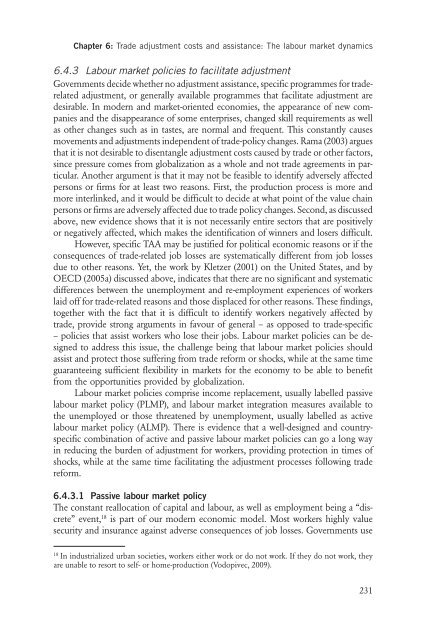Trade and Employment From Myths to Facts - International Labour ...
Trade and Employment From Myths to Facts - International Labour ...
Trade and Employment From Myths to Facts - International Labour ...
You also want an ePaper? Increase the reach of your titles
YUMPU automatically turns print PDFs into web optimized ePapers that Google loves.
Chapter 6: <strong>Trade</strong> adjustment costs <strong>and</strong> assistance: The labour market dynamics<br />
6.4.3 <strong>Labour</strong> market policies <strong>to</strong> facilitate adjustment<br />
Governments decide whether no adjustment assistance, specific programmes for traderelated<br />
adjustment, or generally available programmes that facilitate adjustment are<br />
desirable. In modern <strong>and</strong> market-oriented economies, the appearance of new companies<br />
<strong>and</strong> the disappearance of some enterprises, changed skill requirements as well<br />
as other changes such as in tastes, are normal <strong>and</strong> frequent. This constantly causes<br />
movements <strong>and</strong> adjustments independent of trade-policy changes. Rama (2003) argues<br />
that it is not desirable <strong>to</strong> disentangle adjustment costs caused by trade or other fac<strong>to</strong>rs,<br />
since pressure comes from globalization as a whole <strong>and</strong> not trade agreements in particular.<br />
Another argument is that it may not be feasible <strong>to</strong> identify adversely affected<br />
persons or firms for at least two reasons. First, the production process is more <strong>and</strong><br />
more interlinked, <strong>and</strong> it would be difficult <strong>to</strong> decide at what point of the value chain<br />
persons or firms are adversely affected due <strong>to</strong> trade policy changes. Second, as discussed<br />
above, new evidence shows that it is not necessarily entire sec<strong>to</strong>rs that are positively<br />
or negatively affected, which makes the identification of winners <strong>and</strong> losers difficult.<br />
However, specific TAA may be justified for political economic reasons or if the<br />
consequences of trade-related job losses are systematically different from job losses<br />
due <strong>to</strong> other reasons. Yet, the work by Kletzer (2001) on the United States, <strong>and</strong> by<br />
OECD (2005a) discussed above, indicates that there are no significant <strong>and</strong> systematic<br />
differences between the unemployment <strong>and</strong> re-employment experiences of workers<br />
laid off for trade-related reasons <strong>and</strong> those displaced for other reasons. These findings,<br />
<strong>to</strong>gether with the fact that it is difficult <strong>to</strong> identify workers negatively affected by<br />
trade, provide strong arguments in favour of general – as opposed <strong>to</strong> trade-specific<br />
– policies that assist workers who lose their jobs. <strong>Labour</strong> market policies can be designed<br />
<strong>to</strong> address this issue, the challenge being that labour market policies should<br />
assist <strong>and</strong> protect those suffering from trade reform or shocks, while at the same time<br />
guaranteeing sufficient flexibility in markets for the economy <strong>to</strong> be able <strong>to</strong> benefit<br />
from the opportunities provided by globalization.<br />
<strong>Labour</strong> market policies comprise income replacement, usually labelled passive<br />
labour market policy (PLMP), <strong>and</strong> labour market integration measures available <strong>to</strong><br />
the unemployed or those threatened by unemployment, usually labelled as active<br />
labour market policy (ALMP). There is evidence that a well-designed <strong>and</strong> countryspecific<br />
combination of active <strong>and</strong> passive labour market policies can go a long way<br />
in reducing the burden of adjustment for workers, providing protection in times of<br />
shocks, while at the same time facilitating the adjustment processes following trade<br />
reform.<br />
6.4.3.1 Passive labour market policy<br />
The constant reallocation of capital <strong>and</strong> labour, as well as employment being a “discrete”<br />
event, 18 is part of our modern economic model. Most workers highly value<br />
security <strong>and</strong> insurance against adverse consequences of job losses. Governments use<br />
18 In industrialized urban societies, workers either work or do not work. If they do not work, they<br />
are unable <strong>to</strong> resort <strong>to</strong> self- or home-production (Vodopivec, 2009).<br />
231

















